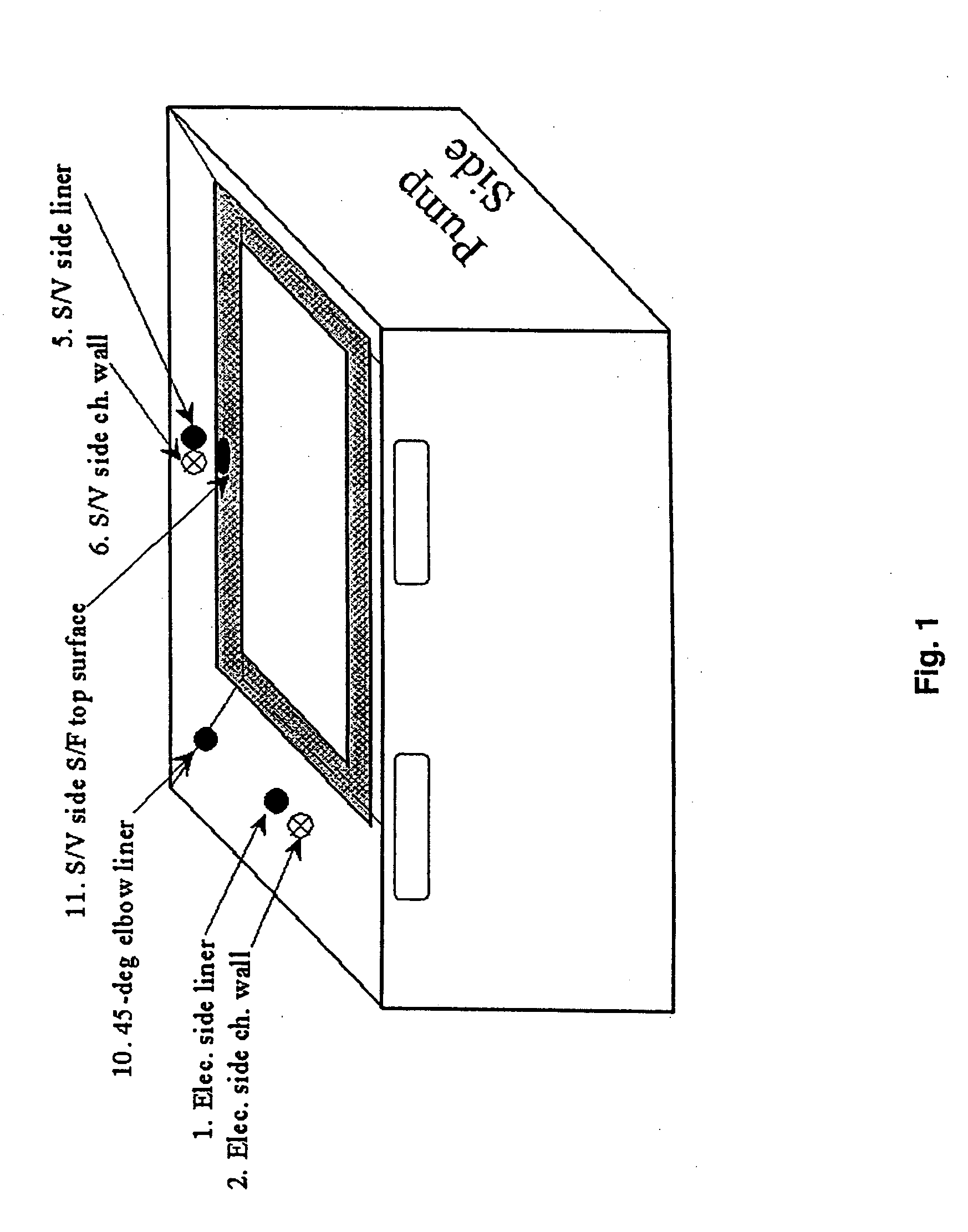Chamber cleaning via rapid thermal process during a cleaning period
a technology of rapid thermal process and chamber cleaning, which is applied in the direction of chemical vapor deposition coating, coating, chemical apparatus and processes, etc., can solve the problems of unreliable processes, defective substrates, undesired residues deposited in or around exhaust channels, etc., to improve the surface temperature uniformity of chamber parts, increase the temperature of chamber parts, and improve the effect of chamber parts temperatur
- Summary
- Abstract
- Description
- Claims
- Application Information
AI Technical Summary
Benefits of technology
Problems solved by technology
Method used
Image
Examples
example 1
Chamber Wall and Liner Temperature Measurement
[0043] In AKT CVD-5500 chamber system, ⅛″ thick ceramic spacers were added between the liners and chamber wall to study heat transfer and liner temperature (FIG. 1). Eleven thermocouples (TCs) were installed, six of which survived (i.e., TC1, TC2, TC5, TC6, TC10 and TC11). The six surviving TCs were Kepton-taped to different places on the chamber wall, liners and shadow frame (for substrate clamping purpose).
[0044] TC1 was attached to the middle of the left-side liner, while TC2 was placed underneath on the chamber wall. Similarly, TC5 was attached to the middle of the slit valve side liner, while TC6 was embedded underneath on the chamber wall. TC10 was placed on the corner elbow-shaped liner, while TC11 was laid on the shadow frame top surface.
[0045] All the temperature readings were recorded at different process conditions though the susceptor temperature was maintained at 350 / 360° C. for inner / outer heater combination. With this ...
example 2
AKT Fat-Belly-Liner Chamber
[0049] In AKT CVD-5500 alpha (A) chamber, 45-degree liners were changed to Fat-Belly type on all sides except the window side (view limited). Table 3 shows the clean rate comparison between the original and Fat-Belly type 45-degree liners.
TABLE 3SiH4Dep. TimeDep. RateCln. TimeCln. Rate(sccm)(sec)(20 mm)(sec)(A / min)GHOrig. Liner6701801851486941Fat-Belly670180181348.7670145-degLinersAHOrig. Liner1310601250135769Fat-Belly1310110126320694745-degLiners
Dep.: deposition; Cln: clean; GH: high-deposition rate SiNx film; and AH: high-deposition rate amorphous silicon (α-Si) film.
[0050] It is shown that Fat-Belly 45-degree liners did achieve faster clean rate in the α-Si cleaning (−20% for AH) case, but in the SiN (GH) case, the clean rate is the same (Table 3). Additionally, Fat-Belly 45-degree liners achieved ˜2-3% better deposition uniformity in α-Si and SiN films. The fat-belly liners are modified liners which are in closer proximity to the active heating de...
example 3
Rapid Thermal Process
[0052] In AKT PECVD systems, a significant amount of cleaning time is spent cleaning the chamber peripheral parts, such as liners which have the lower surface temperatures due to the close proximity to the wall. The rapid heating module can be a high power lamp placed at the bottom of the chamber, or a resistive heater embedded in the wall next to the liner, or a combination of both. It is contemplated that an inductive heater may also be embedded in the wall next to the liner and may be used singly or in combination with the high power lamp and / or the resistive heater.
[0053] When the module heats up, liners and other chamber parts experience a higher surface temperature, which facilitates faster cleaning of the film residues. As was shown in Table 1, a higher surface temperature results in a higher dry etch rate; by extension, further raising the surface temperature of the chamber parts through the action of an RTP module will increase the cleaning rate.
[00...
PUM
| Property | Measurement | Unit |
|---|---|---|
| temperature | aaaaa | aaaaa |
| pressure | aaaaa | aaaaa |
| RF power | aaaaa | aaaaa |
Abstract
Description
Claims
Application Information
 Login to View More
Login to View More - R&D
- Intellectual Property
- Life Sciences
- Materials
- Tech Scout
- Unparalleled Data Quality
- Higher Quality Content
- 60% Fewer Hallucinations
Browse by: Latest US Patents, China's latest patents, Technical Efficacy Thesaurus, Application Domain, Technology Topic, Popular Technical Reports.
© 2025 PatSnap. All rights reserved.Legal|Privacy policy|Modern Slavery Act Transparency Statement|Sitemap|About US| Contact US: help@patsnap.com



